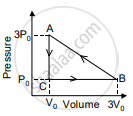Advertisements
Advertisements
Question
An ideal gas of volume 2 L is adiabatically compressed to (1/10)th of its initial volume. Its initial pressure is 1.01 x 105 Pa, calculate the final pressure. (Given 𝛾 = 1.4)
Solution
Given:
Vi = 2 L, Vf = `("V"_"i")/10 ⇒ ("V"_"i")/("V"_"f") = 10, "P"_"i" = 1.01 xx 10^5` Pa, γ = 1.4
To find: Final pressure (pf)
Formula: For adiabatic process: `"p"_"f" "V"_"f"^γ = "p"_"i""V"_"i"^γ`
Calculation:
From formula,
pf = pi × `("V"_"i"/"V"_"f")^γ`
= 1.01 × 105 × (10)1.4
= antilog {log (1.01) + 1.4 × log (10)} × 105
= antilog {0.0043 + (1.4 × 1)} × 105
= antilog {1.4043} × 105
= 2.537 × 106 = 25.37 × 105 Pa
The final pressure (pf) is 25.37 × 105 Pa
RELATED QUESTIONS
An ideal gas is taken through an isothermal process. If it does 2000 J of work on its environment, how much heat is added to it?
Draw a p-V diagram of the reversible process.
Draw a p-V diagram showing positive work with varying pressure.
State the assumptions made for thermodynamic processes.
Explain the cyclic process.
Explain work done during a thermodynamic process.
When food is cooked in a vessel by keeping the lid closed, after some time the steam pushes the lid outward. By considering the steam as a thermodynamic system, then in the cooking process
The V-T diagram of an ideal gas which goes through a reversible cycle A→B→C→D is shown below. (Processes D→A and B→C are adiabatic)

The corresponding PV diagram for the process is (all figures are schematic)
In an isochoric process, we have ____________.
Apply first law for an isothermal process.
Give an equation state for an isochoric process.
Derive the work done in an isothermal process.
Explain in detail an adiabatic process.
Draw the TP diagram (P-x axis, T-y axis), VT(T-x axis, V-y axis) diagram for
- Isochoric process
- Isothermal process
- Isobaric process
In an adiabatic expansion of the air, the volume is increased by 4%, what is the percentage change in pressure? (For air γ = 1.4)
For a given ideal gas 6 × 105 J heat energy is supplied and the volume of gas is increased from 4 m3 to 6 m3 at atmospheric pressure. Calculate
- the work done by the gas
- change in internal energy of the gas
- graph this process in PV and TV diagram
A thermodynamic system undergoes cyclic process ABCDA as shown in the figure. The work done by the system is ______

A monoatomic gas of pressure p having volume V expands isothermally to a volume 2V and then adiabatically to a volume 16V. The final pressure of the gas is ____________.
`("ratio of specific heats" = 5/3)`
An ideal gas is made to go from a state A to stale B in the given two different ways (see figure) (i) an isobaric and then an isochoric process and (ii) an isochoric and then an isobaric process. The work done by gas in the two processes are W1 and W2 respectively. Then,

Two identical samples of a gas are allowed to expand (i) isothermally (ii) adiabatically. Work done is ____________.
An ideal gas A and a real gas B have their volumes increased from V to 2V under isothermal conditions. The increase in internal energy ____________.
Assertion: Equal volumes of monatomic and polyatomic gases are adiabatically compressed separately to equal compression ratio `("P"_2/"P"_1)`. Then monatomic gas will have greater final volume.
Reason: Among ideal gases, molecules of a monatomic gas have the smallest number of degrees of freedom.
Ideal gas for which 'ϒ' = 1.5 is suddenly compressed to `1/4`th of its initial volume. The ratio of 4 the final pressure to the initial pressure is ______.
`(ϒ = "C"_"p"/"C"_"v")`
Which of the following processes is reversible?
In the figure shown here, the work done in the process ACBA is ______.

When an inflated ballon is suddenly burst, why is the emerging air slightly cooled?
